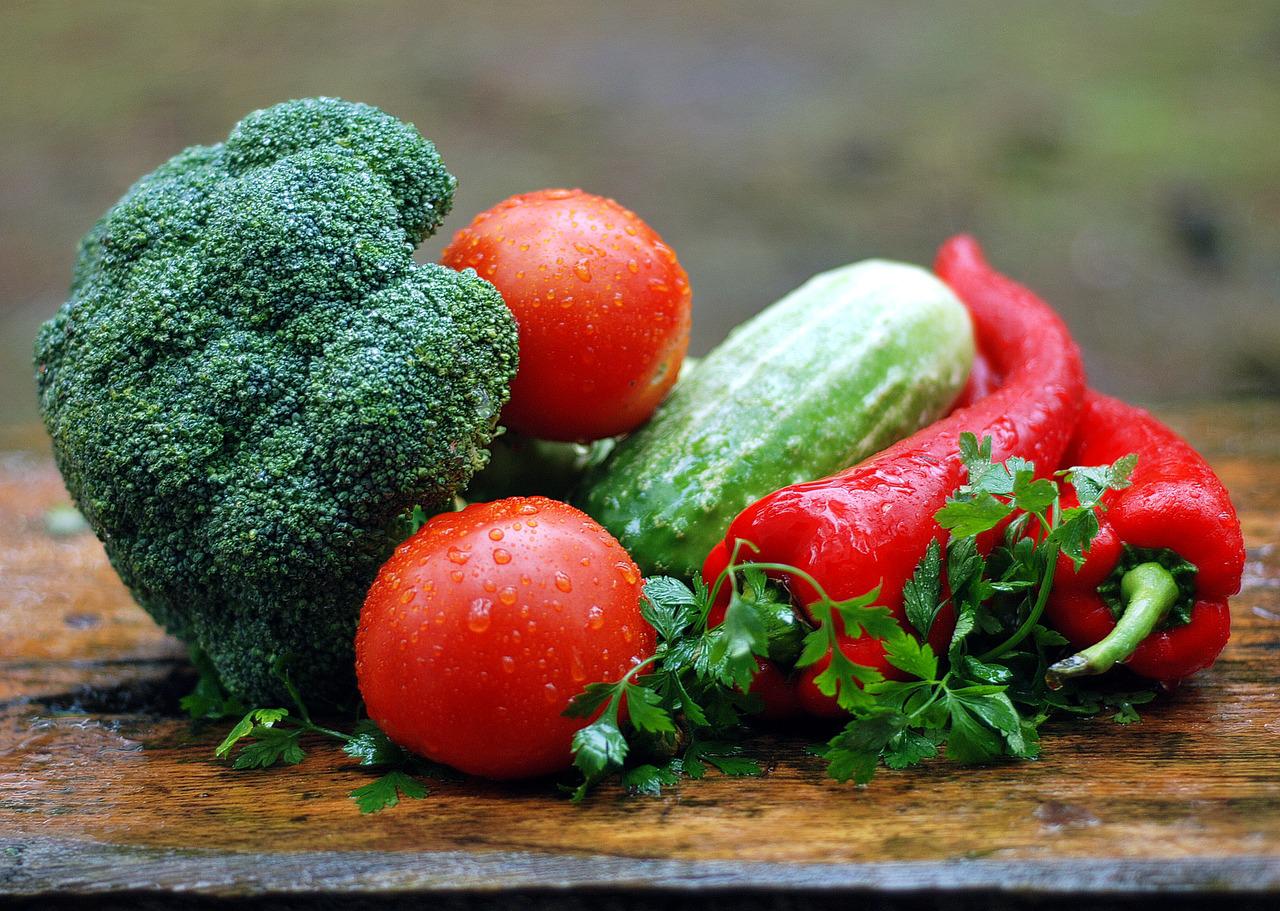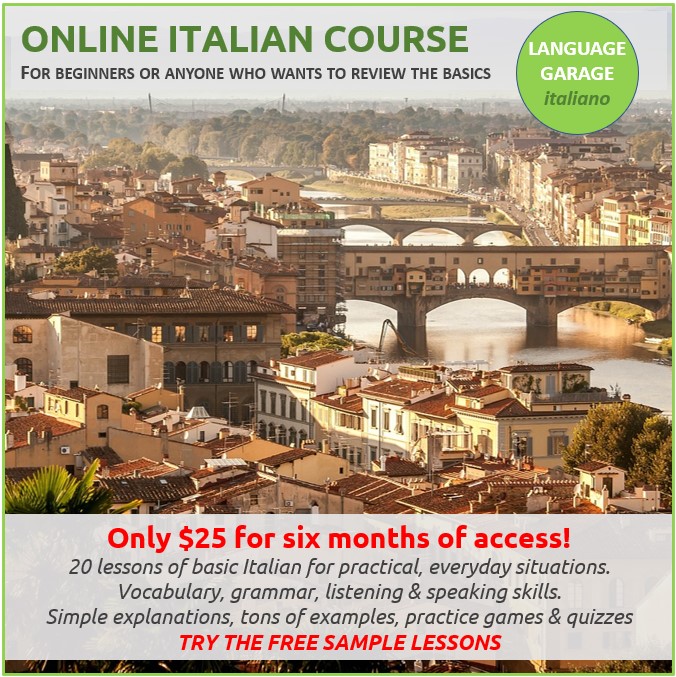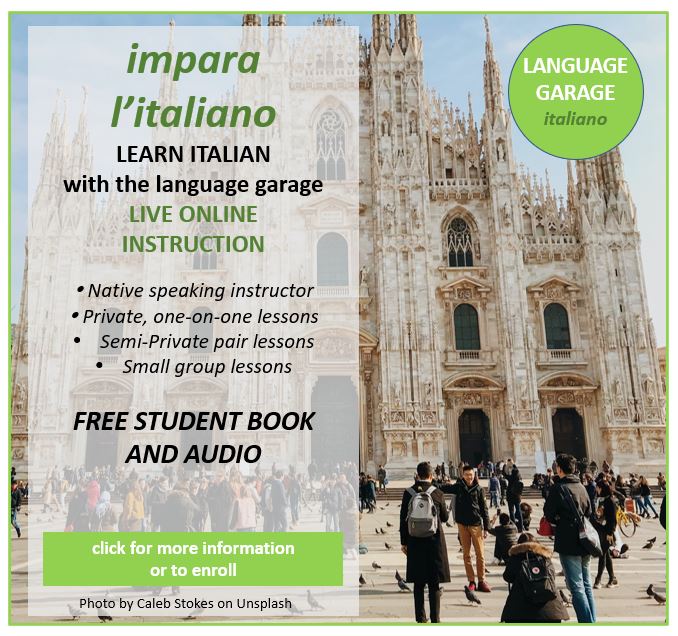Il Cibo: Basic Italian Food Vocabulary
In this post we’ll build your Italian vocabulary by learning about everyone’s favorite language topic: Italian food terms! Italian food vocabulary will come in handy no matter why you’re learning Italian, so let’s dig in.
Ciao! This post is a free sample of a lesson from our online Italian course. The beginner’s course includes all of the vocabulary from our basic mini-lessons, with full audio support by native speakers. The online course also includes simple explanations of basic Italian grammar, plenty of examples, and loads of practice exercises, quizzes, and games. You can check out sample lessons or enroll in the online course here.
Ho fame! I’m hungry!
Let’s start to build your Italian vocabulary by learning some expressions that you’ll probably need to know when you use Italian food vocabulary.
- Ho fame.
I’m hungry. - Ho sete.
I’m thirsty.
- Voglio qualcosa da mangiare.
I want something to eat. - Voglio qualcosa da bere.
I want something to drink. - Ho bisogno di una merenda.
I feel like a snack.
La cena è pronta! Dinner is ready!
You probably want to know how to talk about meals when you’re using Italian food terms. The meals in Italian are la colazione (breakfast), il pranzo (lunch), and la cena (dinner). A snack is una merenda, and dessert is il dolce.
- Cosa c’è per colazione?
What’s for breakfast? - Cosa c’è per pranzo?
What’s for lunch? - Cosa c’è per cena?
What’s for dinner? - Cosa c’è per dolce?
What’s for dessert? - Faccio colazione presto.
I have breakfast early. - Pranzo con i colleghi.
I have lunch with colleagues. - Ceno con la mia famiglia.
I have dinner with my family.
Cosa stai mangiando? What are you eating?
Now let’s see some basic Italian vocabulary related to foods and beverages. We’ll divide these Italian food terms into sections.
- il pane bread
- il riso rice
- la pasta pasta
- le tagliatelle noodles
- la carne meat
- il pollo chicken
- il manzo beef
- il maiale pork
- il prosciutto ham
- l’agnello (m.) lamb
- il pesce fish
- i frutti di mare seafood
- il granchio crab
- il gamberetto shrimp
- l’aragosta lobster
- il calamaro squid
- la vongola clam
- l’ostrica oyster
- il tofu tofu
- le verdure vegetables
- il pomodoro tomato
- la cipolla onion
- l’aglio (m.) garlic
- la lattuga lettuce
- gli spinaci spinach
- gli asparagi asparagus
- il cavolo cabbage
- il fungo mushroom
- il cetriolo cucumber
- il peperone pepper (as in bell)
- il peperoncino chili pepper
- la frutta fruit
- la mela apple
- la pera pear
- la pesca peach
- l’arancia (f.) orange
- il limone lemon
- l’uva (f.) grape
- la fragola strawberry
- la banana banana
- la noce walnut
- l’arachide (f.) peanut
- il seme seed
- il grano wheat
- il cereale cereal
- il sale salt
- il pepe pepper
- il sesamo sesame
- il miele honey
- lo zucchero sugar
- la salsa di soia soy sauce
- l’uovo/le uova egg/s
- il latte milk
- il formaggio cheese
- il burro butter
- l’acqua (f.) water
- il tè tea
- il caffè coffee
- il vino wine
- la birra beer
- il latte di soia soy milk
- il succo juice
- il gelato ice cream
- la torta cake, pie
- la crostata pie
- il biscotto cookie
- la caramella candy
- mangiare to eat
- bere to drink
- cucinare to cook
- assaggiare to taste
- Mangio molto riso.
I eat a lot of rice. - Bevi tè o caffè al mattino?
Do you drink tea or coffee in the morning? - Cucini molto bene!
You cook very well!
Un tovagliolo, per favore. A napkin, please.
Now that you know some basic Italian food vocabulary, let’s see some phrases that will come in handy when you’re ordering food. Some vocabulary related to Italian food terms is: il piatto plate, la ciotola bowl, le posate the silverware, il coltello knife, il cucchiaio spoon, la forchetta fork, le bacchette chopsticks, la tazza/tazzina cup, il bicchiere glass, il tovagliolo napkin.
- Potrei avere un tovagliolo / forchetta / coltello / cucchiaio / bacchette?
Could I have a napkin/fork/knife/spoon/chopsticks? - Potrei avere un bicchiere d’acqua?
Could I have a glass of water? - Dove sono le posate (le forchette, i coltelli, e i cucchiai)?
Where is the silverware? (the forks, knives, and spoons)? - Le posate (le forchette, i coltelli, e i cucchiai) sono nel cassetto
The silverware is (the forks, knives, and spoons are) in the drawer. - I bicchieri puliti sono nell’armadietto.
The clean glasses are in the cabinet. - Le tazzine per il caffè sono sulla mensola/sul ripieno/sullo scaffale.
The coffee cups are on the shelf. - Potrei avere un tovagliolo, per favore?
Could I have a napkin, please?
Com’è il cibo? How’s your food?
Let’s close with some Italian vocabulary that you can use to talk about your food:: delizioso delicious, salato salty, dolce sweet, amaro bitter, aspro sour.
- È delizioso.
It’s delicious. - È ottimo.
It’s great. - Questo cibo è eccellente
This food is excellent. - È troppo caldo.
It’s too hot. - È troppo freddo.
It’s too cold. - È troppo dolce.
It’s too sweet. - È troppo salato.
It’s too salty. - È insipido.
It’s tasteless/bland. - È troppo cotto.
It’s overcooked. - È crudo.
It’s undercooked. - È oleoso.
It’s oily. - È grasso.
It’s greasy.
Do you want to learn Italian?
We hope you’ve enjoyed growing your Italian vocabulary with some Italian food terms. If you want to learn more, check out our other posts on Italian language, culture, and more. And if you’re looking for convenient and affordable live Italian lessons with a real teacher, check out The Language Garage. Our lessons are given online in a virtual classroom, so it doesn’t matter where you live or work – we can come to you. And we have flexible options, with a free trial so that you can decide if there’s a fit. Check us out!
Image: JerzyGorecki on Pixabay







